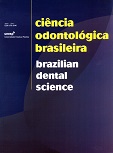Experimental candidosis on rat’s tongue
DOI:
https://doi.org/10.14295/bds.2004.v7i2.484Abstract
The purpose of this study was to evaluate the development of candidosis in rat’s tongue after intraepithelialinjections of Candida albicans. Fifty rats (Rattus norvegicus, Albinus, Wistar), originally negative for the Candidaspp. received ten intraepithelial injections of C. albicans on the dorsal tongue. Groups of five animals werekilled after 1, 2, 4, 6, 8, and 12 hours and 1, 2, 7, and 15 days after the injection. The rat’s tongues weresurgically removed and then macroscopic and microscopic analyses were performed. The development of candidosislesions was observed in all the rats studied. One hour after the injection, the development of germ tubesfrom the yeast cells could be observed. After 4 hours, Candida spp. pseudohyphae penetrated the epithelial cellswith the formation of microabscesses. After 24 to 48 hours, the epithelial areas with pseudohyphae invasionpresented desquamation, hyperplasia of the basal layer and discrete inflammation of the connective tissue. Afterseven days, few pseudohyphae could be observed. The epithelium presented acanthosis, hyperkeratosis and lossof filiform papillae. After 15 days, neither yeasts nor pseudohyphae were found. In some areas, the epitheliumpresented acanthosis and loss of filiform papillae. It can be concluded that the intraepithelial injection of Candidaalbicans on the dorsal rat tongue caused candidosis lesions in all the animals studied. C. albicans waspresent until seven days after the injections.Downloads
Downloads
Published
How to Cite
Issue
Section
License
Brazilian Dental Science uses the Creative Commons (CC-BY 4.0) license, thus preserving the integrity of articles in an open access environment. The journal allows the author to retain publishing rights without restrictions.
=================




























